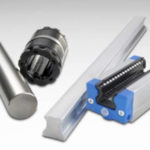The first step in any automation project is to clearly define the objective — what process are you trying to accomplish or what output are you trying to produce? Once the process or output is defined, it’s time to dig into the details of the application so you can choose the right components or systems to achieve the desired result in the most efficient, cost-effective way. Documenting the application parameters will also help you communicate specific requirements to vendors and integrators.
To define a linear motion application, start with three fundamental questions:
- What are you moving?
- How far are you moving it?
- How fast does it need to get there?
Here, the question of “What” refers to the type of load being moved — its mass, shape, and size. Also define where and how the load is oriented relative to the linear motion system, and whether any of these parameters changes significantly during the process.

Image credit: Rollon
Keep in mind that some applications also include axial (pressing) loads, and these need to be considered during the sizing and selection of drive components. And if the load orientation is vertical or inclined, special circumstances need to be taken into account, such as buckling forces on the drive mechanism and the potential for the load to back drive (or worse, for the load to “drop”) if power is lost.
“How far” means the stroke, or travel length, and whether there are any intermediate stops or changes in the stroke over the course of the process. The question of “how far” also leads to precision — defined as positioning accuracy and repeatability, as well as travel accuracy requirements.

“How fast” refers to the move profile of the stroke. The goal might be to move the load to the target position as quickly as possible, but most applications have specific requirements for traveling at constant velocity during part of the move, for dwell time, or even for maximum speed or acceleration due to the nature of the load or safety concerns. The move profile will also determine the required torque and speed from the motor and whether the application requires a gear reducer.

Image credit: Varedan Technologies
When defining the move profile, the duty cycle should also be defined. In other words, how often will the move be made — how many times per minute, hour, or day? The duty cycle affects not only the life of moving components, it also affects the amount of heating the motor will experience during operation and can have a significant influence on motor selection.
Be aware that although these three questions — and the application parameters related to them — cover the main performance requirements of a linear motion system, there are other factors that need to be taken into account as well. For example, any special environmental conditions that the system needs to withstand — such as extreme temperature, cleanroom or vacuum, or contamination — should be defined at the initial stages of sizing and selection, as these can be a determining factor in regards to which components or systems are acceptable.
Fortunately, manufacturers of linear motion components understand that sizing and selecting their products can be a complicated and intimidating process. To help designers and engineers with defining the application, several manufacturers have come up with catchy acronyms that spell out the application parameters required for sizing. Here are a few examples:
Bosch Rexroth: LOSTPED
Bosch Rexroth was the first to develop and promote an acronym that describes the information required for sizing a linear motion system, and these seven parameters are still the foundation of any linear motion sizing project.
Load
Orientation
Speed
Travel
Precision
Environment
Duty Cycle
(I’ve also seen this acronym rearranged as TOPSLED — same seven criteria, just in a different order.)
Rollon: ACTUATOR
Rollon makes the case that time and budget should also be included — because what good is a solution if it doesn’t fit within your budget or can’t be delivered within the required timeframe?
Accuracy
Capacity
Travel Length
Usage (aka duty cycle)
Ambient environment
Timing (aka time and budget)
Orientation
Rates (aka move profile)
PBC Linear: POSTLUDES
PBC Linear has added two criteria — unknown and safety — and formed an entirely new acronym.
Precision
Orientation
Speed
Travel
Load
Unknown (What are the “known unknowns?” What could go wrong?)
Duty Cycle
Environment
Safety
Regardless of which acronym you use — or whether you come up with your own catchy acronym or mnemonic device — remember that the more information you can provide regarding the application, the more likely you are to get a linear motion system that exactly meets the application requirements, without being oversized or undersized.







Leave a Reply
You must be logged in to post a comment.